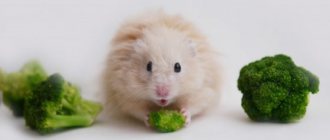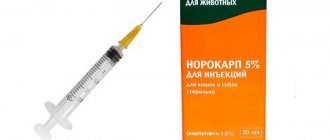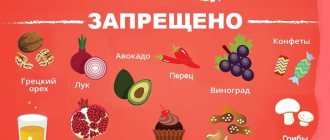Are vegetables necessary in a dog's diet?
In general, a dog is a predator by nature, so the bulk of the diet, about 70-80%, should be foods containing animal protein: meat, fish, eggs, dairy products. The remaining percentage comes from vegetables and a small amount of cereals.
Probably every dog owner has often observed undigested pieces of vegetables in their pet’s feces. The thing is that dogs do not have enzymes that help break down the shell of plant fiber. For this reason, vegetables and greens are poorly absorbed by the animal’s body.
You ask: “So why then do dogs need vegetables if the animal’s stomach is not able to digest them?”
In fact, it is simply necessary to include this type of food in the diet of tailed animals. Vegetables are a source of indigestible fiber and are needed by the animal’s body as slow carbohydrates, a source of coarse dietary fiber, which creates the right prebiotic environment and helps to better digest meat.
Although fiber is not absorbed by the body, it perfectly regulates intestinal function and removes excess cholesterol from the body. In addition, vegetables are rich in vitamins and microelements, so necessary for every living organism.
Do dogs need plant foods?
Dogs are predators. Therefore, their diet should consist of 80% meat and dairy products.
But dogs are not obligate carnivores. Their ancestors did not feed exclusively on animal foods. In the wild, wolves and jackals often eat berries, mushrooms, grass, and tree bark.
In addition, wolves eat the intestines of captured animals. It contains semi-digested plant products.
Therefore, vegetables must be included in the daily menu of dogs. They:
- contain vitamins, minerals and other beneficial elements that are not found in animal products;
- stimulate peristalsis, improve digestion;
- clean teeth from plaque, massage gums.
A dog won't last long on meat alone. Gastrointestinal disorders, chronic constipation and vitamin deficiency are guaranteed for him. A balanced diet must include foods rich in fiber.
In what form should I give vegetables to my dog?
And here the opinions of dog breeders differ. Proponents of the Barf nutrition system, for example, argue that due to the fact that the animal’s body is not able to digest fiber, vegetables should be ground in a blender until pureed.
They refer to the fact that in the wild, the distant ancestors of dogs, wolves, first of all ate the stomach of herbivorous prey in order to obtain a certain amount of plant food, which in turn was already digested in the stomach. In fact, it doesn’t matter at all in what form you give vegetables to your dog.
You can generally alternate serving methods: grind in a blender, grate or cut into cubes or bars. The dog chews vegetables cut into large cubes, thereby also chopping them. Moreover, chewing fresh, raw vegetables further helps prevent plaque formation.
However, this feeding method is not suitable for small puppies and dogs that are being transferred to natural food from dry food. Small puppies simply do not yet know how to chew food well, and an animal switching to natural food is not yet accustomed to certain products and will choose what is tastier for it (and this, of course, will be meat), leaving pieces of vegetables in its bowl.
Not all vegetables are recommended to be cooked. Some of them are best given raw. This way they preserve all valuable vitamins and microelements.
But many vegetables contain beta-carotene, which is better absorbed when stewed with a small addition of animal fat (for example, sour cream or kefir). These vegetables include: carrots, cabbage, tomatoes, eggplants, turnips and beets.
Therefore, it won’t hurt to pamper your pet with a delicious dish of baked vegetables. You can see how I prepare this dish for my Jackusik at the end of the article!
Canned vegetables and herbs are contraindicated for dogs due to the high content of various spices in them.
What to do if you vomit?
Even if the animal does not consume frankly harmful foods, such as potatoes or onions, certain types of vegetables can make him sick - vomiting, diarrhea or constipation, and sometimes problems with the pancreas develop.
The reason for such reactions is individual intolerance to a certain product. In such a situation, you should simply exclude the vegetable that caused such a reaction from the animal’s diet.
What vegetables can you safely give to your pet?
Now let's talk about which vegetables are healthy for dogs and don't cause heated debate.
Pumpkin
Pumpkin improves digestion, reduces the acidity of gastric juice, normalizes stool and treats constipation. Pumpkin is an excellent antioxidant and helps prevent the occurrence of helminths.
Zucchini
Zucchini is a good source of potassium, calcium, beta-carotene and folic acid. As a rule, this vegetable is given raw, but you can pamper your pet with a baked product.
Cucumber
Cucumbers are completely safe for four-legged animals. They are rich in complex organic substances that play an important role in metabolism. The potassium contained in cucumbers improves the functioning of the heart and kidneys.
bell pepper
Bell peppers contain beta-carotene and a number of beneficial B vitamins. Peppers are also rich in potassium and calcium, iron and iodine, magnesium, manganese, phosphorus, fluorine, copper, zinc and sodium.
But in pepper traffic, preference should be given to red pepper, as it contains more microelements and vitamins.
Celery
Earlier, answering the question of what you should not feed your dog, we mentioned that celery is a product rich in potassium, calcium, phosphorus, sodium, amino acids, vitamins A, B and C. The substances contained in this plant have a positive effect on the condition cardiovascular system and prevent the development of cancer.
In addition, celery is an excellent breath freshener and has anti-inflammatory properties, so it can be given to dogs suffering from arthritis. It is recommended to give animals the stem of this plant.
But the consistency of the celery stalk is very hard and fibrous. And since when eating food, the dog does not chew it, but swallows it in pieces, it will be difficult for unchewed pieces of the plant to pass through the animal’s esophagus. Therefore, if you want to introduce this plant into your dog’s diet, then either cut it into small pieces or grind the plant stems in a blender.
Carrot
Carrots are rich in vitamin A and beta-carotene, which help improve vision, reduce the risk of tumors and add shine to the coat.
In addition, raw carrots are good for cleaning plaque on teeth, reducing the number of pathogenic bacteria in the mouth, reducing unpleasant odor and training the jaw muscles.
But be careful, carrots can cause allergies in some dogs.
Cauliflower
Many pet owners are afraid to give this vegetable to dogs, and completely in vain. Cauliflower is absorbed by the body better than all other types of cabbage. It contains less coarse fiber than, for example, cabbage, so it is easily digested and does not irritate the gastric mucosa. It is especially useful for gastrointestinal diseases. For liver and gallbladder disease, only those vegetables that increase the secretion of bile and promote regular bowel movements are recommended. These include cauliflower.
Turnip
Turnips are a rich source of calcium. It has a diuretic, antiseptic and anti-inflammatory effect, improves food absorption. Turnips are good both raw and baked. However, some animals are weakened by this vegetable.
Turnips are not recommended for use in acute diseases of the gastrointestinal tract and chronic diseases of the liver and kidneys.
Radish
Radish contains a lot of coarse fibers and is a kind of toothbrush for the animal. However, it is not recommended for pets with gastrointestinal problems.
Green bean pods
Green bean pods are very good either fresh or boiled. They are an excellent addition to tripe dishes.
In the winter, I often buy frozen bags of green beans and add this vegetable to Jack's meals.
Method of preparing vegetables
Root vegetables can be fed raw, stewed or boiled. The method and need for heat treatment depends on the characteristics of the vegetable. Most are better digested by the digestive system after processing. Some dog lovers recommend alternating cooking methods. It's also helpful to change up the cutting options periodically, varying between blending or dicing. It is preferable to give grated root vegetables to older animals.
Stewed vegetables are better digestible
Chewing raw vegetables prevents tartar from forming on your teeth.
Advice from veterinarian nutritionists:
- Raw root vegetables are not suitable for feeding puppies. They are not able to chew them thoroughly.
- Some vegetables, such as carrots, contain beta-carotene. This element is better absorbed when steamed.
- The celery stalk is very tough. Dogs preferentially swallow the root vegetable without chewing. Therefore, before feeding it should be cut into small pieces or crushed.
- Eggplants should be given no more than once a week.
- Consumption of canned vegetables is prohibited.
- It is advisable to feed root vegetables at the same time as meat.
- Green beans make a great addition to tripe-based dishes.
- You should not combine raw vegetables with fermented milk products.
- It is recommended not to give red root vegetables to pets with white hair, as there is a high probability of allergic reactions.
Useful microelements are better preserved in unprocessed root vegetables
By following these simple recommendations, you can enrich your pet’s diet and improve its digestive processes.
Vegetables that are controversial about their benefits or harm
There are vegetables that are not strictly prohibited. However, some of them are not beneficial enough, while others are not suitable for all dogs and can cause serious harm to the pet's health if due care is not taken.
Beet
This root vegetable is rich in potassium, antioxidants and folic acid. But this is a rather allergic vegetable.
If your dog is not allergic to beets, then a small amount will only be beneficial. Eating this vegetable will give a rich and bright color to dogs with red hair. In large quantities it can cause diarrhea.
Tomatoes
Tomatoes are generally included in the list of foods not recommended for dogs because, when fed in large quantities, they can cause stomach upset, cardiac dysfunction, rapid heartbeat, muscle weakness and tremors.
However, in small quantities, it is quite a healthy vegetable. Tomatoes serve as an excellent prevention of plaque formation. They are a strong antioxidant and a good remedy for fighting inflammatory processes.
Therefore, if the dog is not allergic to tomatoes, then it is recommended to include them in the four-legged diet in reasonable quantities. Fresh ripe tomatoes are the safest.
Broccoli
Some dog breeders have undeservedly included this vegetable in the list of not recommended. This was done because this variety of cabbage contains a substance called isocyanate, which is a toxin for dogs and can cause the death of the animal.
However, in order for this vegetable to do any harm, you need to give it to your pet daily in large quantities and as only the only vegetable.
Broccoli is rich in microelements and vitamins C and K. And in terms of vitamin A content, it surpasses all other cabbage plants. All valuable vitamins are preserved much longer in frozen cabbage. Therefore, I safely buy frozen broccoli and, from time to time, add it to my Jack’s food along with other vegetables.
Cabbage
White cabbage is an excellent source of sulfur, calcium, potassium, phosphorus, beta-carotene and vitamins A, B and C. And, I must say, many pets love it very much because they can crunch and chew hard pieces of leaves.
But fresh cabbage is not recommended for dogs in large quantities, as it causes gas formation, stomach turmoil and intestinal pain. But with boiled or stewed cabbage, you can pamper your pet from time to time.
Eggplant
This vegetable is rich in fiber, phosphorus, iron and carotene. However, it is not recommended to be given to animals with kidney disease. Eggplant can cause allergies in some dogs. Recommended for feeding baked or slightly stewed, but not on an ongoing basis.
List of foods that can be given in limited quantities
Veterinarian nutritionists consider it inadvisable to consume a number of root vegetables that do not bring particular benefits. And some vegetables can be given to a dog, but with caution:
► Turnip.
Served baked or raw. A valuable source of calcium, but may be a little weak. You should not eat vegetables with serious gastrointestinal, kidney or liver problems. Product value:
- Improves food digestibility.
- An excellent antiseptic.
- Removes excess fluid from the body.
► Radish.
Its coarse fibers clean your pet's teeth just as well as a toothbrush. Consumed raw, but not recommended for animals with gastrointestinal problems. Advantages:
- gives elasticity to the walls of blood vessels;
- lowers cholesterol levels.
► Tomatoes.
If overused, they can cause diarrhea. Negatively affects the functioning of the heart muscle. Only ripe fruits are chosen for food. In small doses it is quite a useful product:
- Fights plaque formation.
- An excellent antioxidant.
- A good anti-inflammatory agent.
► Eggplant.
Can be given in limited quantities only after heat treatment. Rich in fiber, carotene, phosphorus and iron. Contraindicated in dogs with allergies, pets with diseased kidneys and liver.
► Beetroot.
The rather allergenic root vegetable is rich in potassium, folic acid and antioxidants. Saturates the color of the coat of those with a red color. In large quantities it will cause diarrhea.
► Broccoli.
Rich in vitamins C, K, A. Along with valuable substances, it also contains isocyanate, a toxic substance for dogs. The product can supplement the diet in an amount of no more than 10% of the total composition, so as not to cause harm.
► White cabbage.
An excellent source of vitamins and microelements. Four-legged friends love to gnaw on its crunchy leaves. However, when fresh, it provokes bloating with pain. This vegetable is best cooked or stewed for dogs.
Vegetables not recommended for feeding
There is a certain list of vegetables that are not recommended for feeding to a dog.
Corn
In general, corn is not a dangerous vegetable for dogs. But you can’t call it useful either. Corn is often added to cheap pet foods because it is inexpensive, high in fiber, and very filling. This is, perhaps, all her dignity.
Although corn is a source of protein, dogs do not have the enzymes to digest it. Therefore, at the exit you can see whole, undigested grains.
However, despite the dubious benefits of this vegetable, corn is perhaps the most important component of dry dog food.
Potato
In its raw form, this vegetable is a source of solanine, a very dangerous and toxic substance.
As for boiled potatoes, they are a rich source of carbohydrates and starch, which contribute to obesity and joint problems, arthritis.
All the more strange is the fact that despite the absolute uselessness of this product, very often in the composition of expensive animal feed you can see starch as the main filler.
Onion and garlic
It is believed that dogs should absolutely not be given onions and garlic. This is due to the fact that onions and garlic contain thiosulfates, which negatively affect red blood cells and can cause anemia (anemia).
But in order for serious problems to arise, you need to regularly feed your pet 5-6 heads of garlic per week! You understand that this is simply physically impossible!
If your dog accidentally eats a small piece of onion, nothing bad will happen. Sometimes I give one clove of garlic to Jack along with a dried piece of bread as a prophylactic against helminths.
Legumes
Peas, beans, lentils, beans do not provide any benefit and are poorly digested by the animal’s body, causing flatulence.
Mushrooms
Everyone knows that mushrooms, like a sponge, absorb harmful substances from the environment. They attract heavy metal salts and radioactive particles like a magnet and are poorly absorbed due to the high content of chitin in them.
If the human body can digest such heavy food, then eating mushrooms by a dog can lead to disruption of the pancreas and liver. Therefore, it is better not to take risks and completely exclude this product from the animal’s diet.
List of useful
Dogs digest most types of vegetables perfectly (with rare exceptions). So, you can safely include in your animal’s diet:
- cucumbers;
- tomatoes;
- zucchini;
- white cabbage;
- pumpkin;
- carrot;
- beets;
- corn;
- eggplant;
- bell pepper
Most vegetables can be given to dogs raw, after cutting them into small pieces, but many dogs will not mind boiled pumpkin or zucchini.
Important : eggplants, tomatoes and beets should be given with caution and in small portions - these vegetables can cause an allergic reaction in some dogs.
Do dogs need greens?
Just like with vegetables, a dog's digestive system is not designed to digest greens. And the pets themselves do not have any particular passion for young shoots of edible herbs, especially aromatic ones. But it is still necessary to include them in the diet in small quantities due to the huge content of valuable vitamins and minerals in greens.
The following types of greens are useful: lettuce, dill, parsley, fresh nettle and dandelion leaves, burdock leaves and stems, seaweed (a source of iodine and microelements that have a beneficial effect on wool and skin), spinach.
From time to time you can include basil, mint, and lemon balm in your diet.
Nuances of vegetable nutrition for puppies and adult dogs
You need to be careful with cabbage.
Having studied all the above data, every breeder can easily create a healthy diet for their pet. The main thing here is moderation and balance. Yes, vegetables should definitely be given to dogs so that they feel better and get less sick.
On the other hand, if a dog eats dry food rather than natural food, then restructuring the diet can lead to unexpected consequences.
Attention! Puppies need to be especially careful when giving foods that cause bloating and diarrhea - they tolerate such problems very poorly and may even die.
Vegetables and fruits are prohibited
When analyzing whether dogs can eat vegetables and which ones, you need to familiarize yourself with the forbidden fruits:
- Grapes are in first place in terms of harmful effects on the animal’s body. In most cases, it can cause kidney failure in pets. After eating grapes, small breed dogs suffer from diarrhea and vomiting.
- Pomegranate disrupts digestion and irritates the gastrointestinal tract. The bones are very toxic to small dogs.
- Avocado contains a substance that depresses the heart and respiratory system of dogs.
- Peach pits are poisonous and the fruit itself causes diarrhea.
- Quince can cause difficulty swallowing and vomiting, leading to severe loss of fluid.
- It is strictly undesirable to offer rutabaga to your pet. The root vegetable is a strong allergen and causes thyroid disease.
Citrus fruits: benefit or harm?
So, what vegetables and fruits can you give dogs? And how do citrus fruits affect the animal’s body? The sharp, specific smell of New Year's fruits is unpleasant for many dogs. But there are also exceptions.
Nevertheless, the same tangerines are rich in vitamins A, B1, B2, B6, C, E, PP. In addition, they contain calcium, potassium, phosphorus, magnesium, and sodium. Citrus fruits also contain easily digestible proteins, carbohydrates and fats.
All these substances are very useful for your pet. However, citrus fruits are strong allergens. Dogs, like people, have personal intolerance to the product. A negative reaction to eating fruit can be hormonal imbalance, problems with the thyroid gland and pancreas. In addition, fruits can have a toxic effect on the body.
However, if your pet loves tangerines or oranges, you can pamper him with one or two slices of his favorite fruit from time to time without fear of serious consequences.
Eggplant is useful
To ensure that such a nutritious vegetable as eggplant is on hand even in the cold season, it can be preserved in three ways:
- Cook the finished dish.
- To freeze.
- Dry.
The first option is suitable for those who have several large dogs living at home. Buying, cutting and preparing vegetables every time is a rather lengthy process. Therefore, prepared eggplants in the form of stew or caviar will always come in handy.
It is more convenient to freeze eggplants for dogs in pieces. In this form they will take up less space and are ideal for instant boiling.
For drying, unripe eggplants with thin skin are taken. You can dry them in special dryers, ovens, or on a rope around the apartment. Before drying, eggplants must be cut into thin strips.
Favorite and exotic fruits
Not all garden fruits are recommended for shaggy pets. When discussing what vegetables and fruits dogs can eat, one cannot help but think of exotic foods. It is immediately necessary to make a reservation that overseas fruits should be given with caution, infrequently and in small quantities.
Papaya is a fragrant, sweet fruit that pets enjoy eating. A small slice of peeled fruit can stop diarrhea. But a large amount of fruit causes constipation and increases blood sugar.
Kiwi is rich in vitamin C and valuable fruit acids. If you give this fruit to a dog, then no more than once every 2-3 weeks. A small circle of kiwi will enrich the animal’s body with beneficial vitamins.
Soft varieties of persimmon without pits or peels will help normalize intestinal function and strengthen loose stools. It helps a lot with diarrhea and indigestion.
Apricots should also be given peeled and pitted. It contains hydrocyanic acid. After eating even one apricot seed, a dog can die. The fruit itself is very nutritious. But in young dogs and puppies it can cause diarrhea. Therefore, it is recommended to give apricots to your pet with caution.











